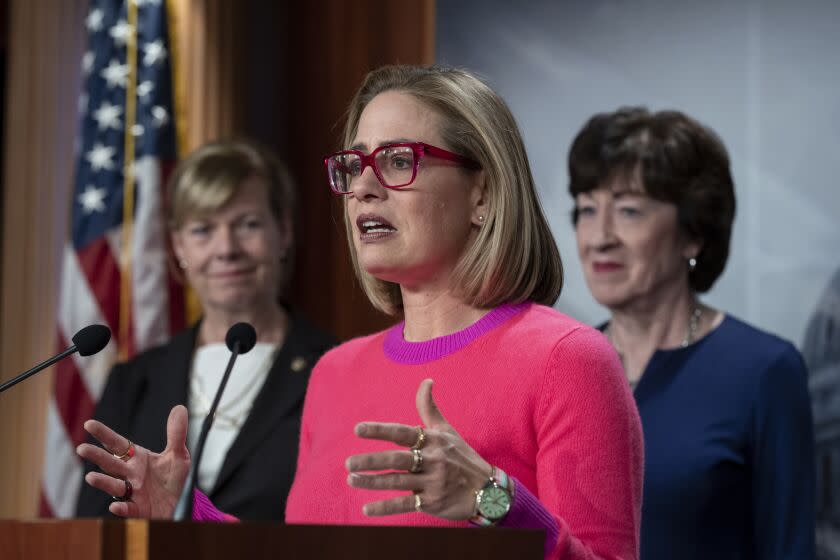Granderson: Challenging Kyrsten Sinema makes the primary so wild that national Democrats will just stand back

- Oops!Something went wrong.Please try again later.
- Oops!Something went wrong.Please try again later.
I first heard rumors about Rep. Ruben Gallego challenging Sen. Kyrsten Sinema within small political circles in Arizona last summer. Liberal discontent for Sinema reached my ears much earlier. Years ago.
In fact, it wasn’t long after Sinema became the country’s first openly bisexual senator, in 2019, that local LGBTQ grassroots leaders began noticing it was getting more difficult to get Sinema to make appearances at queer events.
The community’s frustration spilled over last year after she refused to end the filibuster on two voting rights bills. More than 100 LGBTQ leaders and allies in Arizona sent a joint letter to the Human Rights Campaign demanding that the national LGBTQ civil rights organization withdraw its support of Sinema. In December, Sinema quit the Democratic Party and declared herself an independent.
So as you can see Gallego’s announcement on Monday that he would challenge Sinema in the Democratic primary has been somewhat of a slow train coming. Funny thing is while having a Democrat officially challenge Sinema puts the national party in an awkward situation, it’s actually the frustrated liberals in Arizona who are now on the clock.
I’ll explain.
The deadline to report all of the money a candidate receives and spends in the first quarter is April 15, but the books close March 31. That leaves Gallego and his supporters a little more than two months to raise enough money to prove there’s either enthusiasm for him or enough blue anger at Sinema to warrant national resources. And it can’t just be big checks from outsiders. There needs to be proof that there would be votes as well as dollars. As one political operative told me, national leaders will be focusing more on the small checks from local residents to gauge how viable Gallego’s chances are before deciding how to back him.
And if his first-quarter numbers are strong, the national party will have to back him, which will undoubtedly affect how the incumbent maneuvers in the Senate. Though keep in mind, Sinema has yet to announce she’s even seeking reelection. Senate Majority Leader Chuck Schumer wouldn’t say whether he would endorse her if she did. Senate Democratic Whip Dick Durbin wouldn’t say either. Neither would Gary Peters, chairman of the Democratic Senatorial Campaign Committee.
If this were baseball, she would be out. But this is politics, and Gallego — while liked — isn’t necessarily known around the state for his fundraising prowess, I’m told. So, national Democrats aren’t being coy, as much as patient. They really don’t have to say anything until the wallets in Arizona do first.
Besides, this whole dynamic is new to all of us.
While we have independents besides Sinema in the Senate now, Maine and Vermont don’t have nearly as many variables to negotiate, starting with race. Maine and Vermont are more than 95% white. Nearly a third of Arizonans are Latino. Indigenous and Black make up another 11%. Then there’s the politics surrounding the border — and I’m not talking about the Canadian one. But the biggest variable is size. Of the 4.3 million registered voters in the state, a third are independents.
Like Sinema.
Republicans are first and Democrats are actually third on the list.
So the math gets complicated quickly for national Democrats. Whatever they do, they don’t want to set up a general election contest in which an election-denying Republican has a shot at the seat.
This is why the Federal Election Commission quarterly report is so instrumental in determining the party’s next move. The amount of local money going to Gallego — or another challenger — provides clarity. Unless there is a measurable indication that liberal voters in Arizona are really ready to move on from Sinema, why would Schumer and company speak against her during the primary and alienate a potential ally? And remember, Gallego must prove he’s a viable candidate not only against Sinema but against whatever Republican might emerge to face him.
But who knows, in the end Sinema may decide she could be more effective (and better paid) out of office, clearing the path for a more traditional general election race. Her profile has been raised, and her expertise will be sought. She may see the lukewarm liberal support and daunting path to reelection and decide she’d rather make time to appear at some of those queer events again.
This story originally appeared in Los Angeles Times.

